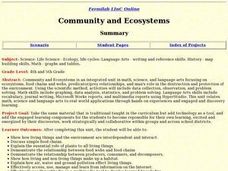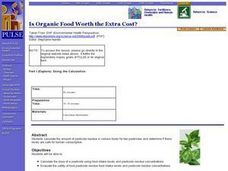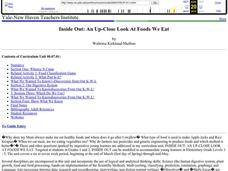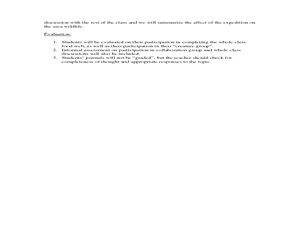Curated OER
What Is It? Tommy Tastes
Students complete multi-curricular to learn about senses and sensory words. In this sensory words lesson, students discuss the five senses and the anatomy of a tongue. Students complete a food tasting activity and find descriptive words...
Curated OER
What is it? Sally Smells!
Students explore the attributes of the human nose. In this 5 senses activity, students participate in a smell guessing game prior to discussing the anatomy of the nose and creating a sense of smell book page.
Curated OER
Guess What I Came From
First graders examine items made from plants. In this plant lesson plan, 1st graders read Plants Feed on Sunlight and view a PowerPoint presentation regarding plant growth. Students examine products that are made from plants and draw...
Curated OER
Yummy for my tummy!
First graders read the story Tops and Bottoms and identify vegetables that are eaten from the stem, root, and leaf of a plant. In this vegetables lesson plan, 1st graders learn vocabulary about different vegetable parts and write journal...
Curated OER
Exploring Indiana's Natural Resources
Fourth graders complete a variety of activities as they study the European exploration of the Midwest, focusing on Indiana. They map the path explorers took, comparing the British with the French. They research why the explorers stopped...
Curated OER
Community and Ecosystems
Students complete a unit of lessons on ecosystems. They participate in online activities, create a diorama, write journal entries, and develop a Hyperstudio multimedia project on a selected ecosystem.
Curated OER
From McGee's Farm to the Movies
Students participate in several plant-themed activities. They keep a food log, identify any plants they have eaten and then classify these foods by the part of the plant that is edible. Students sing songs about plants, make collages,...
Curated OER
Is Organic Food Worth the Extra Cost?
High schoolers calculate the amount of pesticide residue in selected foods for two
pesticides and determine if these levels are safe. They read an article about a
research study looking for metabolites of these pesticides in children....
Curated OER
Inside Out: An Up-Close Look At Foods We Eat
Fourth graders identify the origins of meats and vegetables consumed by humans on a daily basis. They classify foods (meats, dairy products, grains...) and create a food pyramid.
Curated OER
Vocabulary Charts
Learners create their own vocabulary charts. They divide into groups and view an example of a vocabulary chart imbedded in this plan. Then, they create their own chart which is based on a particular subject area.
Curated OER
What's the Hold-Up?
Students explore the current plan by New York City Mayor Michael Bloomberg to retain underperforming third graders in public schools. They research and debate social promotion versus retention.
Curated OER
Rain, Rain, Go Away
Students conduct a number of experiments involving evaporation and condensation. They view and discuss a video about the water cycle and then design posters about the rain based on the book "Cloudy With A Chance of Meatballs".
Curated OER
Common and Science Names
First graders investigate how dinosaurs are named. They listen to the book "The Littlest Dinosaurs," discuss Greek and Latin words and word parts, identify the word parts and meanings of Triceratops, and create a drawing of a dinosaur...
Curated OER
Have a Backone
Students create a visual organizer that describes different groups of vertebrates in this pre-writing activity. They view and discuss a video on descriptive writing and then form small groups to research vertebrate classes using the...
Curated OER
Get to know H2O!
Students investigate scientific concepts and inquire about physical states of matter. The transition of water is considered and is easy to facilitate because of its abundance and often observed physical changes.
Curated OER
work in pairs for the activities of this lesson which include researching and identifying butterflies, writing, and a brief oral presentation.
Students explore the concepts of rdioactive decay and dating. They generate a radioactive decay table, use their data to plot a decay graph, develop the concept of half-life, and then use the graph to find the age of a mummified seal in...
Curated OER
CSI: Native America
Students discuss the murders of Native Americans in Indiana. In groups, they research and make drawings of the scene as if they were part of a CSI team. They complete any needed experiments to help them solve the crime and create a...
Curated OER
Lesson plan: History Underfoot
Students study Native Americans of Virginia. In this Virginia history lesson, students take on the role of archaeologists as they analyze a site and its artifacts. Students use the information to draw conclusions about the natives who...
Alabama Learning Exchange
I'm so Crushed
As an experiment is demonstrated for them, learners write down their observations and brainstorm questions that can help them understand what they saw. After watching the experiment again—which demonstrates a soda can collapsing due to...
Alabama Learning Exchange
Seeds: How They Grow
Students observe the growing stages of plants. In this plant growth lesson plan, students collect, germinate, and plant seeds to chart the growth process of plants.
Alabama Learning Exchange
What Color Are The Leaves?
Young scholars identify the colors in leaves. In this chromatography lesson, students read the book Why Do Leaves Change Color? and construct chromatography strips to identify the colors of leaves.
Curated OER
Catching Some Rays
Sixth graders explore the tilt of Earth's axis. In this Earth lesson, 6th graders read a Greek mythology story explaining why there are seasons. Students build a sun-ray gathering tool from styrofoam, glue, thermometers, skewers, and...
Curated OER
The Daily News
Students complete a news writing activity and improve their writing skills. In this news writing lesson, students write about an activity they experience each day of the week. Students use the articles to make a newspaper about their year.
Curated OER
Animals and the Food Webs that Love Them
Students study the animals that Lewis and Clark would have encountered. In this animals lesson students study the food web and how human populations have affected them.






















